
TRINIDAD, Colorado – When the New Elk mine reopened amid windblown prairies last winter, it attracted little attention. But the mine – a long shaft boring through some of the world’s most valuable coal – strikes at the heart of a growing debate about the future of American coal.
On one side are advocates of the U.S. coal industry and people living in places like Trinidad, a city in southern Colorado that has fallen from wealth to poverty in one generation. In the early twentieth century eastern money financed local steel mills and the city built Colorado’s first public schools and hospitals. But as demand for local coal evaporated over the coming decades, Trinidad’s economy faltered: the county’s population plummeted from 40,000 to 15,000 and unemployment rose to 15 percent.
So when Canada’s Cline Mining Corporation announced plans to rebuild the mine and ship much of its coal to Asia, locals began to hope for a civic revival. Echoing a common sentiment in Trinidad, David Hadad, the 72-year-old owner of a Main Street furniture store says the city’s economy is “about as tough as things have ever been here, but now we’re optimistic because the coal’s coming back.”

On the other side of the debate is a loose-knit group of environmentalists opposed to rising U.S. coal exports, particularly exports to China, which consumes almost half of six billion tons of coal used globally each year.
As Cline Mining sought permits to open its Trinidad mine, environmental organizations including the Sierra Club and Earthjustice, a non-profit law firm, petitioned Colorado’s Bureau of Land Management to block the sale.
In part, the groups argued that the state government should consider the possible impact of the mine on global warming. The mine “could add 75 million tons” of carbon dioxide, the most important anthropogenic greenhouse gas, over its life, the groups said in a letter to the bureau.
They and other activists worry that rising U.S. exports undercut hard-won successes to cut domestic reliance on coal. Laws aimed at reducing air pollution mean little if pollutants from burning coal make their way into the atmosphere overseas, they argue, adding that the transport of coal halfway around the world leads to greater pollution and new or reopened mines leak unknown amounts of methane, a potent greenhouse gas.
“We’ve been more and more recognizing the need to address exports to Asian markets and other international markets,” says Roger Singer, the Colorado representative of the Sierra Club’s national “Beyond Coal” campaign. “We don’t simply want to pass on the pollution that was occurring here to developing countries.”
GARGANTUAN APPETITE
Driving the debate are the unfolding environmental impacts unleashed by China’s rapid rise to prosperity. As China has maintained three decades of unprecedented economic growth, it has outstripped its resources and begun scouring the world for more, in the process becoming the world’s top consumer of everything from coal, logs and iron ore to shark fins and tiger bones. It has also become the planet’s top producer of a wide range of pollutants, among them carbon dioxide and mercury, a neurotoxin. Both are released when coal is burned.
Experts have been particularly astonished by how rapidly China is sucking up global coal supplies, leading investors to expand mines and open new ones. Between 1997 and 2007, Chinese demand for coal more than doubled to 3.5 billion tons, according to the U.S. government’s Energy Information Administration. The growth added the equivalent of two Americas worth of coal demand in only 13 years.
Given China’s rapid growth, analysts predict its appetite for fossil fuels will continue its steep upward curve: The International Energy Agency predicts China will account for half of global coal demand growth over the next two decades; the World Coal Association, a London-based industry lobby, estimates that Chinese demand for coking coal – high-grade coal used to produce iron – will rise 50 percent as China continues to build new cities, roads and bridges.
The demand has spurred a surge in mining. Last year an Australian company signed a $60 billion contract – the country’s largest export contract ever – to supply coal to Chinese power plants. In the United States, Interior Secretary Ken Salazar announced in March that the federal government would sell four Wyoming land leases expected to open 758 million tons of coal to mining.
Arch Coal, the second-largest coal producer in the United State, expects exports will account for 20 percent of company sales in 2030, up from 5 percent today. “I actually think the next decade is going to be one of the best decades we’ve ever had,” Steve Leer, Arch’s chief executive, told The Wall Street Journal in February.
MIGHTY MINERS
The stakes of the debate are highest in communities like Trinidad, a city with a complicated relationship to coal. Hundreds of locals have died in mine accidents and the town became a hotbed of union activity in the early twentieth century.
But Trinidad was also built with coal money, and locals are proud of their history: the mascot of Trinidad High School is the “Mighty Miner” – a muscular man holding a pickaxe and dynamite – and when the Colorado and Southern Railroad retired its last coal-burning steam engine in 1963, the local government parked it in front of a downtown grocery store.

Unsurprisingly, support for the reopened mine is nearly unanimous among Trinidad’s citizens.
At the Savoy Café downtown, owner Diane Velarde says she hopes mining will rebuild a community fractured by a loss of jobs.“When I was growing up in the seventies, the mines were open and the streets were full of people, but when the mines closed, they sort of closed Trinidad,” she says.
A no-nonsense woman with warm, brown eyes, Velarde adds that locals don’t care where Trinidad coal is shipped as long as someone is buying: “No one would have thought in the seventies or eighties that we’d be exporting to China. But now we need to open our minds and find that opportunity.”
The American coal industry has made similar arguments as it pushes to build ports capable of handling hundreds of millions of tons of Asia-bound coal. Last year, Arch Coal and Australia’s Millennium Bulk Terminals initiated a process to build a port near Portland, Oregon. In April, Kinder-Morgan, a company that transports energy, announced that it would ship coal to China from its port in Houston, Texas. And in February Peabody Energy, the largest coal company in the United States, announced that they would work with SSA Marine to build a planned coal terminal in Washington state.
“We’re opening the door to a new era of U.S. exports from the nation’s largest and most productive coal region to the world’s best market for coal,” Peabody Energy Chairman Gregory H. Boyce said in a statement. The export of American coal “offers a unique way for America to benefit from major Asian economic growth,” he added.
ENVIRONMENTAL FEARS
Two hundred miles north of Trinidad in Boulder, Colorado, the Sierra Club’s Roger Singer worries that increased U.S. coal exports will drive up consumption, since any rise in supply reduces the global market price, at least in theory. The Sierra Club only began to focus on limiting American coal exports late last year but has since stepped up the campaign, he says.
“We recognize that greenhouse gas emissions affect us planet-wide,” Singer says. “Whether that carbon dioxide is released here or in China, it’s going to have the same net impact on our glaciers and ecosystems and atmosphere.”
The Sierra Club and other groups have opposed the construction of the new West Coast ports and recorded their greatest victory to date when Millennium Bulk Terminals withdrew its application to build a port in Washington, pending further review. The port, which may yet be built, would have been the first major coal-exporting facility on the West Coast.
But industry experts say the desire for jobs will overcome opposition.
“U.S. exports (by volume) have not been affected at all by environmental opposition,” says Fred Palmer, Peabody Energy’s senior vice president for government relations. “It’s a question of supply and demand.”
David Schaaf, the owner of TK Mining Services, the Colorado company hired to manage the New Elk mine, argues that efforts to stop exports are misguided, since China will simply buy the coal from other countries. “China’s demand is a huge opportunity for everybody,” Schaaf says. “There’s a lot of profit to be made, but we need to move or we’ll miss the boat.”
And even if the West Coast ports aren’t built, companies may find other outlets. Cline Mining plans to ship coal by rail to Corpus Christi, Texas and from there to Asia, particularly to China, Japan and Korea, the company said in a press release. Cline Mining executives declined several interview requests.

The Sierra Club is looking for ways to block the export of New Elk mine coal but had no concrete plans, Singer said: “If we can find a hook, we’ll use it to question, slow down, and possibly prevent altogether the export of this coal.”
In Trinidad, where the New Elk Coal Mine began digging again in February, few people hope that happens.
“People are excited,” says Steven Kelly, director of a non-profit organization working to strengthen Trinidad’s economy. “We just had three new businesses open on Main Street and the mine had something to do with that.”
“You can sort of feel the town vibrating,” he adds. “It’s clear something big is going to happen.”




